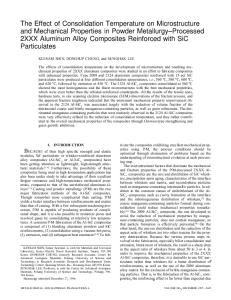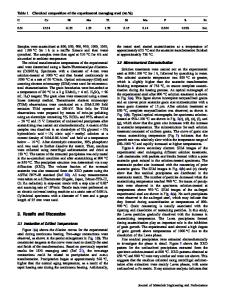Influence of Intercritical Temperature on the Microstructure and Mechanical Properties of 6.5 Pct Ni Steel Processed by
- PDF / 2,881,392 Bytes
- 12 Pages / 593.972 x 792 pts Page_size
- 115 Downloads / 291 Views
UCTION
LIQUEFIED natural gas (LNG) is being widely used as a source of clean energy fuel in a wide range of applications, such as civil gas and heating. However, safe storage and transport of LNG require designated structural units with strict design requirements; 9 pct Ni steel, with a relatively high Ni content, has excellent cryogenic toughness and strength and is utilized as an important structural material for LNG storage tanks.[1–3] However, the high price of Ni hinders large-scale utilization and urges the development of Ni-containing steel with a lower Ni concentration.
QI-YUAN CHEN, WEI-NA ZHANG, JIA-KUAN REN, JUN CHEN, and ZHEN-YU LIU are with the State Key Laboratory of Rolling and Automation, Northeastern University, Shenyang 110819, P.R. China. Contact e-mail: [email protected] ZHANG-LONG XIE is with the Nanjing Iron and Steel Co., Ltd., Nanjing 210035, P.R. China. Manuscript submitted August 24, 2019. Article published online April 3, 2020 3030—VOLUME 51A, JUNE 2020
In general, 9 pct Ni steel is processed by conventional quenching and tempering (QT) treatment. The quenching results in a dislocated lath martensite structure, whereas a small amount of blocky reversed austenite is formed at high-angle grain boundaries during tempering.[4] Strife et al.[5] have observed that the decrease in Ni content reduces the amount of reversed austenite and deteriorates cryogenic toughness. To increase the amount of reversed austenite, various processing routes have been developed,[6–10] in which quenching-intercritical quenching (i.e., lamellarizing, L)-tempering (QLT) treatment is the most commonly used for Ni-containing steels. Kim et al.[6] employed QLT treatment to produce a 5.5 pct Ni steel and demonstrated that the addition of an intercritical quenching step promotes the formation of reversed austenite between laths, which improved the cryogenic toughness at the expense of strength. Controlled rolling and ultra-fast cooling (UFC) can obtain finer martensite laths and improve the strength of steel plates instead of reheating and quenching in the QLT treatment.[11,12] Based on this advanced technology, a novel UFC-LT treatment, consisting of UFC after controlled rolling, intercritical quenching (L) and tempering (T), has been proposed for manufacturing 3.5 pct METALLURGICAL AND MATERIALS TRANSACTIONS A
Ni and 5 pct Ni steels with a desirable combination of strength and cryogenic toughness.[13,14] UFCU¨-LT treatment is a complex process including microstructural recovery and multiple austenite reversion, which is especially sensitive to the heat treatment temperature. However, the influence of heat treatment temperature on the microstructure and mechanical properties during UFC-LT treatment has not been investigated yet. Herein, we aimed to improve the mechanical properties of UFC-LT-processed 6.5 pct Ni steel by controlling the intercritical temperature and attained a similar performance as 9 pct Ni steel. Moreover, the effect of intercritical temperature on microstructural evolution, strength and cryogenic
Data Loading...











